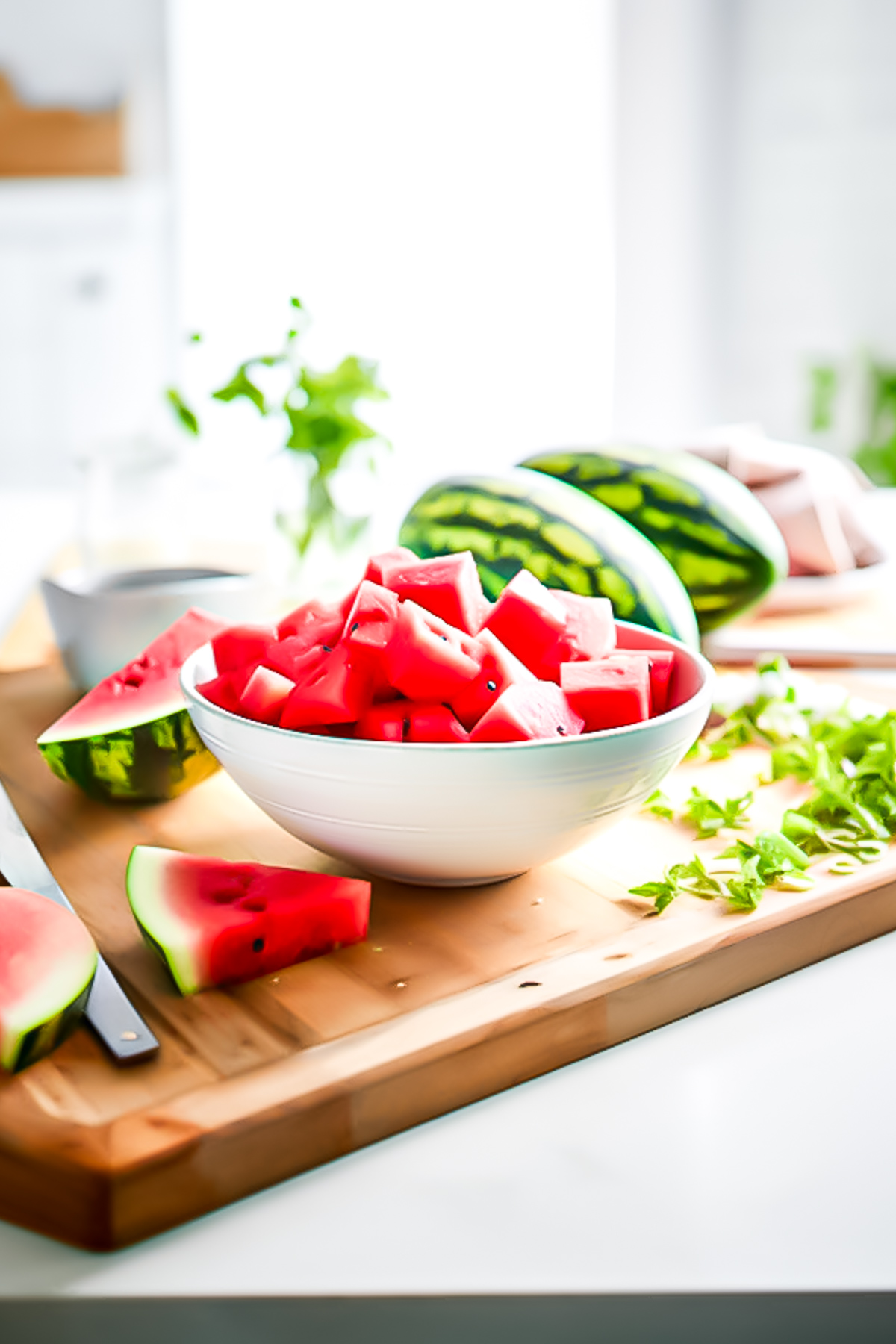Are you ready to dive into the world of watermelons? There's nothing like a sweet, juicy watermelon on a hot summer day. It's a delicious fruit that can be the star of your fruit salads, drinks, and more. But to truly enjoy this refreshing treat, you need to know how to spot the good watermelons from the bad ones. So, let's get into how to tell if watermelon is bad with this simple guide.
One of my favorite summertime dishes to serve on a hot day is our Watermelon Salad with Goat Cheese. It combines the crunch of baby cucumbers, the tanginess of crumbled goat cheese, and the zip of a fresh lime dressing that goes perfectly with cut-up watermelon chunks.

Evaluating An Uncut Watermelon
The first step in finding a good watermelon may start at your local grocery store, farmer's markets, or even your favorite roadside stand. When dealing with a whole watermelon, it's difficult to tell what it looks like inside.
Unfortunately, unlike a canned good, watermelons aren't stamped with an expiration date that reflects shelf life. That would be great, though, wouldn't it? If you start with a watermelon that isn't great, it's downhill from there. So we must use some clues to determine which is worth your money.
- Appearance - A good rule of thumb is to start with a watermelon that looks nice. Look for a uniform green color with dark green stripes. Avoid watermelons with white stripes, as they may not be ripe yet.
- Size Matters (Sometimes) - Watermelons come in various sizes depending on variety, and size isn't necessarily an indication of ripeness. So choose one that suits your needs. While larger watermelons may have had more time to mature, small ones can also be perfectly ripe.
- Inspect the Field Spot - The field spot is the part of the watermelon that sat on the ground while it was growing. A creamy yellow field spot indicates ripeness. Avoid watermelons with a white or green field spot.
- Tap it Gently - Give the watermelon a light tap. You want to hear a hollow sound, suggesting it's ripe. If it sounds dull, it might be underripe.
- Uniform Shape - A good watermelon should have a consistent, symmetrical shape. Irregularities may indicate uneven ripening.
- Examine the Watermelon Rind - Look for any dark spots, soft spots, or signs of mold on the watermelon's rind. These are tell-tale signs of spoilage. In some cases, a yellow rind can be a sign of overripeness. As a watermelon ripens, its skin color may change from a bright green to a more yellowish or orangey hue. This can indicate that the watermelon is past its prime and may not be as sweet or flavorful.
- Touch and Feel - Gently press your fingers on the watermelon's surface. A ripe watermelon should feel firm and slightly springy. If it feels mushy or overly soft, it's probably past its prime. Avoid watermelons with a dull finish to the rind and those with any blemishes or cuts to the surface.
- Smell it - Give it a sniff. It should have a sweet, pleasant smell. If it smells unpleasant or sour, it's likely an overripe watermelon.
Handling Your Whole Watermelon
Once you've picked out the perfect watermelon, the next step is to handle it properly to maintain its freshness. Here are some tips until you're ready to use the watermelon.
- Store at Room Temperature - If you plan to enjoy your whole watermelon soon, store it at room temperature. It can sit on your countertop for a few days without issue.
- Avoid Direct Sunlight - Keep your watermelon away from direct sunlight, as exposure to heat can cause it to overripen or develop dark spots.
- No Plastic Wrap Needed - There's no need to wrap your whole watermelon in plastic wrap or put it in an airtight container. It's happiest just hanging out on your kitchen counter.
Time to Cut Your Watermelon
You've determined that your uncut watermelon is a keeper. Now, it's time to slice it open. The inside of the watermelon can tell you a lot about its freshness.
- Color - The flesh of the watermelon should be a vibrant red color for most varieties. Some watermelons may have a pale pink or orange hue, depending on the type. If you notice any red-brown patches, it's a sign of spoilage.
- Texture - When you take that first bite, the watermelon's flesh should be juicy and crisp. It should have a high water content, giving it a refreshing, thirst-quenching quality. If it's dry or has a gritty texture, it's not good.
- Seeds - If your watermelon has seeds, they should be black. Yellow or white seeds indicate an underripe or bad watermelon. However, I prefer seedless watermelons because I don't have to pick out all the seeds.
- Smell - The watermelon's flesh should have a sweet, fresh watermelon aroma. It's a sign that the watermelon has gone bad if it smells off or unpleasant.

Dealing with Pre-Cut Watermelon Packages
If you've opted for the convenience of pre-cut watermelon from your local grocer, you still need to be vigilant and check for freshness to avoid the chance of food poisoning,
- Check the Packaging - Inspect the packaging for any signs of damage, moisture, or signs of mold. If the packaging is compromised, it's best to avoid it.
- Appearance of the Watermelon - Look through the packaging to assess the appearance of the watermelon. The flesh should be consistent in color, free of any dark spots, and not overly moist.
- Smell it - Open the package and take a whiff. It should have a pleasant, sweet smell. An unpleasant odor is a clear indication of spoilage.
- Texture Change - If the watermelon appears to have gritty flesh, it is often a sign that it has become mushy and mealy and is overripe.

How to Store Watermelon for Later
If you've cut up your watermelon but can't finish it all in one sitting, you can store it for later consumption. Here's the best way to do it:
- Refrigeration - Place your cut watermelon in a sealed container or resealable bag. Keeping it airtight is essential to prevent it from drying out or absorbing odors from the fridge.
- Use it Within 3-4 Days - The shelf life of cut watermelon in the refrigerator is generally 3-4 days. After that, it may start to lose its freshness.
- Freezing - If you can't finish it within a few days, consider freezing it. Place the watermelon cubes in heavy-duty freezer bags, remove as much air as possible, and seal them tightly. Frozen watermelon can be used later in smoothies, frozen desserts, sauces, or soup bases. However, we don't recommend using frozen watermelon for salads.















Leave a Reply